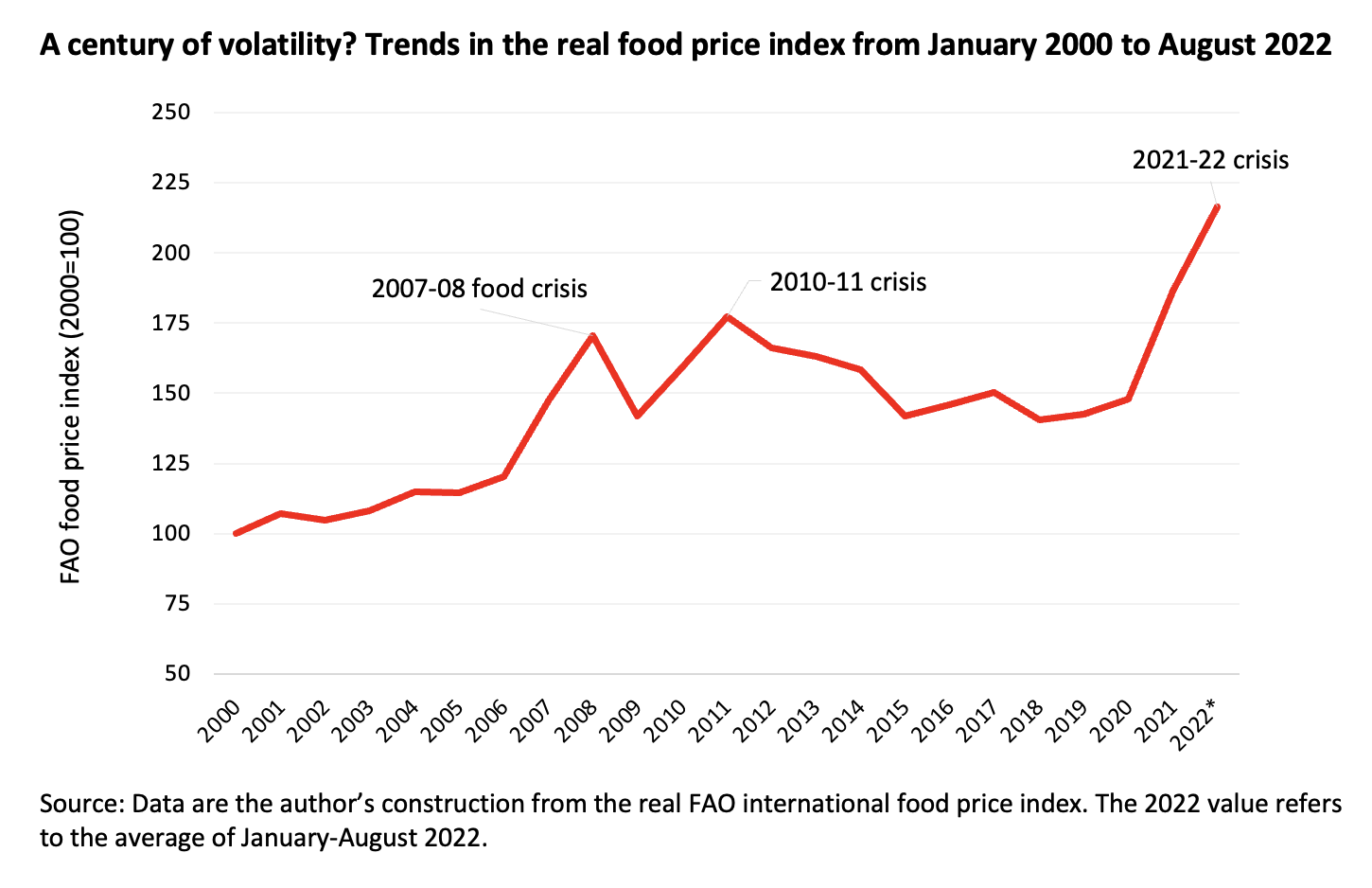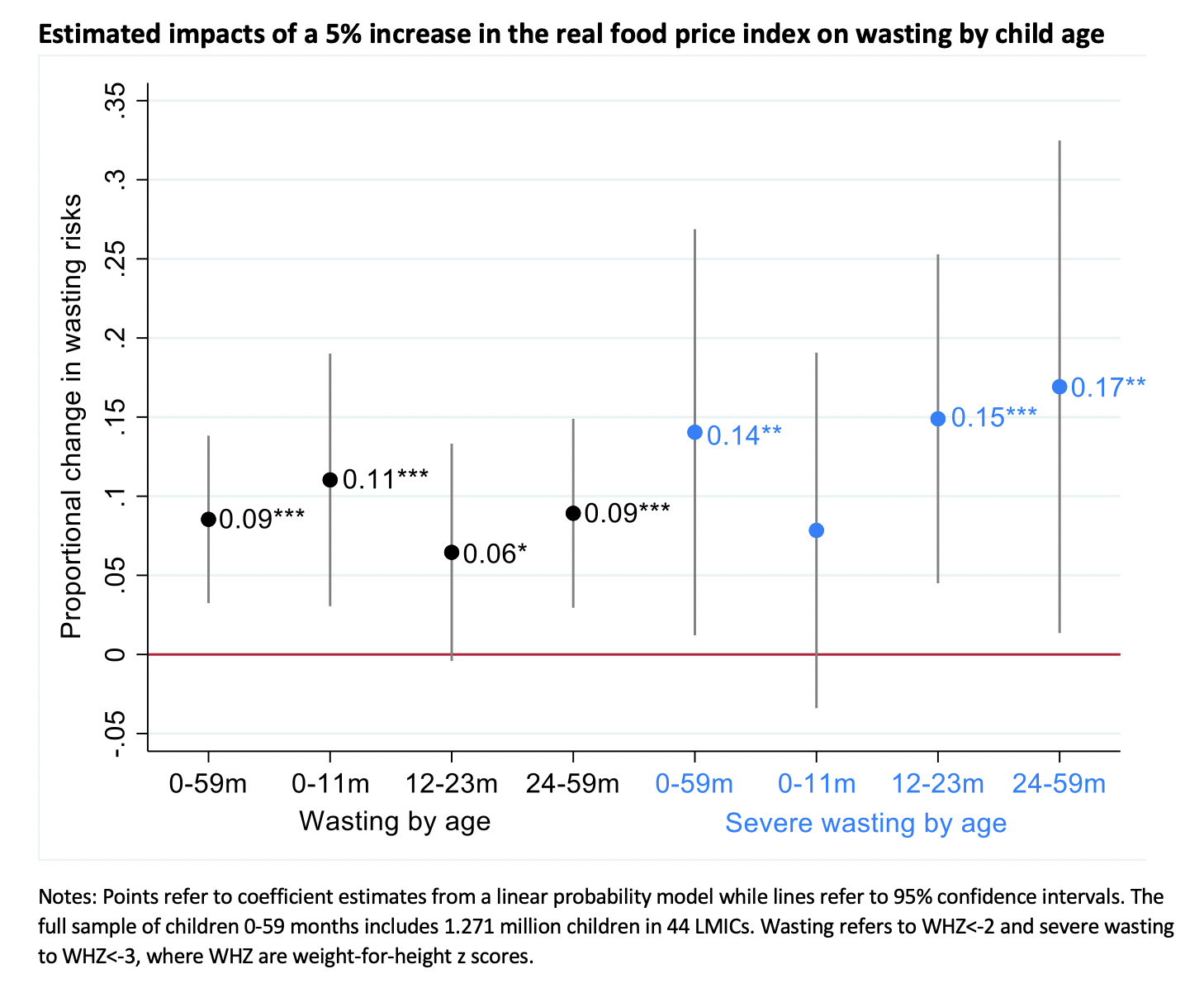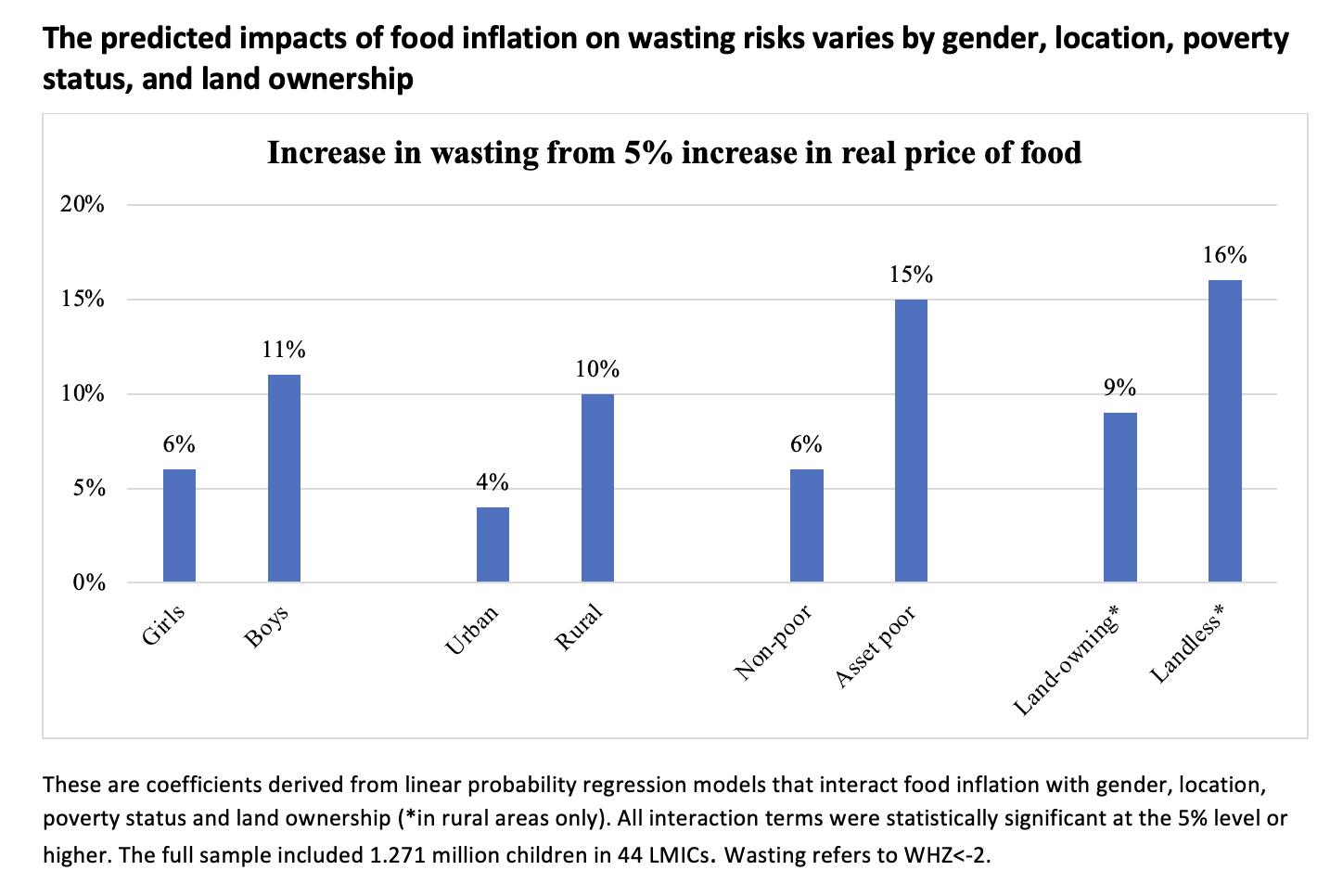The global food price crisis threatens to cause a global nutrition crisis: New evidence from 1.27 million young children on the effects of inflation

Frequent food crises with spiking prices have become the new normal in the 21st century, bringing urgency to the task of understanding their nutritional impacts on poor and food insecure populations. In a new analysis of 1.27 million children in 44 low- and middle-income countries (LMICs) we show that exposure to food inflation in the womb and first years of life is associated with greater risks of child wasting in the short run and stunting in the long run. Food inflation also poses larger wasting risks for children of poor and landless rural households, exacerbating existing inequalities.
These results show the urgency of policies focused on improving maternal and young child nutrition, and the importance of broadening actions to reduce food price volatility and boost access to nutritious foods.
The age of volatility: Food prices in the 21st century
Food prices have become extremely volatile over the past two decades. We are now in the midst of a third international price spike in 15 years, as food prices surged upwards in late 2021 due to the tailwinds of the COVID-19 pandemic, before skyrocketing in the wake of Russia’s invasion of Ukraine. By March 2022, the UN Food and Agriculture Organization (FAO) international food price index had reached an all-time high, 116% greater than its 2000 value—higher even than the peaks reached in the 2007-2008 crisis. More recently, international prices have fallen but domestic food inflation in LMICs remains high by historical standards, and exceptionally so in countries hit by economic mismanagement, conflict, or poor governance. For example, food prices in Sri Lanka had risen 100% by the third quarter of 2022 compared to 12 months earlier, but also soared in Pakistan, Laos, and Ethiopia.
Figure 1
Increases in international food prices are clearly a threat to the welfare of the poor, especially after the severe impacts of COVID-19 on poverty and malnutrition. IFPRI simulation models suggest that rises in food, fuel, and fertilizer prices are associated with poverty increases in the short run, even if rural economies can benefit from higher prices in the longer run.
Little is known, however, about the impacts of food inflation on child nutrition in the short or long run. Optimal maternal nutrition during pregnancy and child feeding practices in early life play a critical role in stimulating development and protecting health and nutrition at all stages of the life course. . So as food prices rise and households’ access to nutritious foods and healthy diets declines, a major concern is that the nutrition of pregnant and lactating women and their young infants, whose nutrient requirements are high, may suffer the most.
While one study from Mozambique examined the impact of food inflation on nutrition at the country level, our study is the first to look at this question on a “global” level. It uses nutritional data from 130 Demographic Health Surveys (DHS) conducted over 2000-2021 in 44 LMICs, which we link to a monthly index of national changes in the ratio of food prices to overall consumer prices—i.e. “real” food price changes.
For wasting—a measure of short term or acute malnutrition—we test the effects of food price increases in the three months prior to wasting measurement. Those predicted risks are shown in Figure 2 for all wasting (in black) and severe wasting (in blue), by child age. Food inflation is associated with higher risks for wasting and severe wasting and the effect size is large and generally robust across ages. Across all children 0-59 months of age, a 5% increase in the real price of food is associated with a 9% higher risk of wasting and a 14% higher risk of severe wasting. In separate tests, we find that infants 0-5 months of age are also at increased risk of wasting, suggesting a maternal nutrition pathway during pregnancy. However, food inflation was also associated with poor dietary diversity among children 6-23 months, suggesting an additional postnatal pathway.
Figure 2
Which are the most vulnerable groups?
Poverty studies tell us that poor, rural and landless households are typically more vulnerable to inflation shocks, while nutrition-focused studies often find that male infants are more vulnerable to shocks than females. Here too we find that food inflation predicts larger wasting risks for male children, rural children, and children from asset-poor and landless households (which lack the option of growing their own food in the face of rising food prices in markets) (Figure 3).
Figure 3
The long run nutrition costs of short run economic shocks
Even brief nutritional insults can have long term consequences on child growth and development, especially insults that occur during the first 1000 days of life when the biological foundations for optimal nutrition, health, and development are established. Our study found that price increases during pregnancy and the first year of life were associated with a greater subsequent risk of stunting at age 3-5 years, with stronger effects for severe stunting.
Policies and programs to protect young children and mothers
This study has important implications. The impacts of food inflation strike very early in the first 1000 days of life, during pregnancy and infancy, and hit the rural poor and landless especially hard. These results demonstrate the urgent need to strengthen women’s nutrition and health before and during pregnancy to ensure optimal prenatal health and nutrition support for their own nutritional benefit and that of their young child.
Maternal and child food or cash transfers (possibly with health/nutrition conditionalities) could provide protection throughout the first 1000 days and beyond, especially if they are targeted at the poorest groups and combined with nutrition-and health-focused social behavior change communication, and adjusted for inflation. Multi-dimensional early warning systems also warrant further investment in an era of greater food price volatility and more extreme weather events, as do programs designed to prevent and manage severe acute malnutrition. Finally, food policies should aim to achieve greater stability in food prices and improve the affordability of nutritious foods. Many suggested policy responses to the 2007-08 crisis are still relevant today; so too is more contemporary advice on repurposing agricultural policies to make healthy diets more affordable. Recommendations include scaling up investments in climate-smart and nutrition-smart agricultural R&D, new approaches to grain reserves, closer regulation of biofuels policies, trade reform to prevent export restrictions especially, and more adaptive and more nutrition-sensitive social protection programs to protect the incomes and diets of high-risk populations.
Derek Headey is a Senior Research Fellow with IFPRI's Poverty, Health, and Nutrition Division (PHND); Marie Ruel is Director of PHND. This post is based on research that has not yet been peer-reviewed.
This research was funded by: the Micronutrient Forum, USA, on behalf of the Standing Together for Nutrition (STfN) consortium through a grant from Global Affairs Canada and the Children's Investment Fund Foundation (CIFF); the Food Prices for Nutrition project funded by the Bill and Melinda Gates Foundation (BMGF) and the United Kingdom government’s Foreign, Commonwealth & Development Office.


